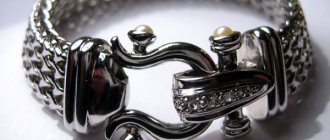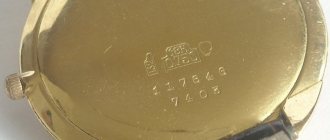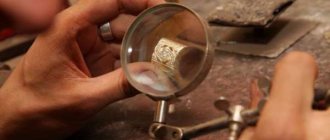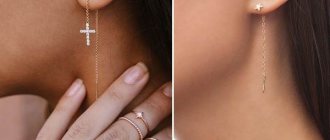Chief editor of the site:
Snitkovsky Arkady Alexandrovich
Chief physician of the professorial dentistry “22 Century”, dentist, orthopedic dentist
Author of the article:
Scientific team of dentistry “22 Century”
Dentists, candidates and doctors of medical sciences, professors
One of the classic methods of prosthetics in dentistry is gold crowns on the tooth.
One of the classic methods of prosthetics in dentistry is gold crowns on the tooth . This is a relatively inexpensive (no more expensive than metal-ceramics and ceramic crowns) option for restoring a damaged tooth, reliable and durable.
The effectiveness of prosthetics using gold crowns and their affordability make them a worthy alternative to metal-ceramics . At the 22nd Century clinic, dental prosthetics using gold crowns is widely practiced.
Use of gold in dentistry
There are two ways to make such crowns: stamped and cast. For stamped ones, special blanks are made. Cast products are cast from gold using wax casts. They do not require any adjustment during installation because they already have a certain size. Cast products are more expensive than stamped ones, but in this case the tooth has to be ground much harder.
Dental crowns from 850 to 900 gold are used. In order for the prosthesis to be stronger, it is made not from pure gold, but with the addition of silver and copper.
How to care?
High-grade gold does not require special care or cleaning with expensive products. It is enough to observe standard oral hygiene: brush your teeth with your usual toothpaste in the morning and evening. For additional protection, dentists advise rinsing your mouth after eating with mouthwash or plain water. Also, visit the dentist twice a year to have your teeth examined for diseases, assess the condition of your crowns, and have your mouth professionally cleaned.
Indications and contraindications
There are both indications and contraindications for the installation of such dental products. First of all, these are situations where it is possible to install only gold prostheses. Such cases include:
- the need to strengthen teeth;
- improving the aesthetic appearance of the row;
- restoration of teeth actively involved in the chewing process;
- the need to restore the previous shape of the tooth;
- Having a strong bite or teeth grinding habit.
There are a number of contraindications for installing gold crowns. It is not recommended to install them:
- under the age of 16;
- for diseases associated with the psyche;
- during pregnancy;
- with periodontitis.
If you are thinking about installing gold crowns to decorate your teeth, then stop. There is an easier way to decorate your teeth - grills:
Removable prosthetics
This type of prosthetics is used in cases of multiple missing crowns. The main difference between these systems is that they can be periodically removed for cleaning. Designs of this type include acrylic, nylon and clasp dentures.
These designs are a classic option that was one of the first to be developed. Plate dentures are indicated in the complete absence of crowns or most of them. Thanks to the use of inexpensive acrylic, this type of construction is considered the most budget-friendly.
The price of a removable device consists of two factors: manufacturing and installation. As a rule, in large cities the price range is wider and amounts to 10 – 20 thousand for the installation of one jaw.
In small towns, the average cost of this service is about 12 thousand rubles.
At the same time, the price for a full plate denture differs little from the price for a partial one.
Clasp removable
Unlike the previous option, clasp dentures are more expensive, since their design involves the use of a metal frame and fixing elements. The device is used for both single and multiple included defects of a number of teeth.
The cost of the clasp will be calculated based on the coverage area and method of fastening. Based on the coverage area, one-sided (simple) and two-sided (complex) models are distinguished. Double-sided models are more complex to manufacture, so their price is 5–10 thousand higher than for simple products.
If the patient decides to opt for a design with clasps, he will have to pay approximately 25,000 rubles. If special locks are installed as locking elements, the product will cost about 50 thousand rubles.
Fixed prosthetics involves the installation of structures with permanent fixation. The cost in this case will depend on the chosen method. The choice of technique is made by the dentist, taking into account the characteristics of the patient.
For the manufacture of artificial crowns, a variety of materials are used, differing from each other in physical characteristics and aesthetic properties. As a rule, the price of crowns is influenced by the aesthetics of the material.
Dental clinics offer the following types of crowns for prosthetics:
- Metal. This is the simplest and most affordable method of prosthetics. Installing one crown will cost approximately 5 thousand rubles. For the manufacture of crowns, a cobalt-chrome alloy is used, which is characterized by increased strength.
But low aesthetic properties make this type of dental restoration unclaimed. In some cases, such products can be coated with a plastic coating, which gives artificial teeth a natural appearance.The price in this case is 7,000 rubles.
In addition to the standard alloy, a gold alloy is used to make crowns, which increases the cost of the product several times. The price of one unit starts from 15,000 rubles.
- Metal-ceramic. They are distinguished by high strength and good aesthetic qualities due to the combination of a metal frame and ceramic coating.
Of all the options that meet aesthetic requirements, metal-ceramic crowns are the most affordable. Their price varies from 6 to 12 thousand rubles. This difference in price is explained by the manufacturing method.The most durable and expensive crowns are made using CADCAM technology. Crowns made using classical technology will have a minimal price.
When choosing, you should take into account that crowns made from domestic materials will be much cheaper than their imported counterparts.
If an alloy of precious metals was used for the base, the price of the crown will be 15 – 17 thousand rubles.
- Ceramic.
In terms of their aesthetic characteristics, they are superior to all other crown options. Porcelain or zirconium dioxide are used for production. The zirconium dioxide product is the most expensive. Its price is 16,000 rubles. It will cost a little less to install a porcelain crown, the cost of which is 11,000 rubles.
When performing prosthetic crowns, it should be taken into account that the cost of the service will additionally include the installation of temporary crowns made of plastic. The price of one unit is 1 thousand rubles.
We suggest you read: How long does blood bleed after wisdom tooth removal (photos and videos)
Bridges
In the absence of a group of teeth, prosthetics with bridge-like structures are used, which are divided into three groups:
- Metal-ceramic. They are a one-piece structure made of cobalt-chrome alloy by casting and coated with ceramic coating. The price of a cast bridge is 18 thousand rubles.
- Ceramic. Made from expensive zirconium dioxide. The cost of a design that includes 3 crowns is 50 thousand rubles.
- Adhesive.
The most affordable option for bridge prosthetics. The bridge is formed directly in the patient's mouth using a composite material that is installed on a fiberglass thread. Restoring a tooth this way will cost an average of 8 thousand rubles.
Tooth preparation and crown installation
Preparation and installation of prostheses requires certain stages. For this process you need:
- Prepare the tooth. If caries is present, carry out special treatment and replace the filling.
- Before the procedure itself, the tooth should be numbed.
- The tooth is ground down on each side and adjusted to the thickness of the crown. It is given the required shape. Be sure to leave small ledges to secure the crown.
- The next step is taking impressions of the upper and lower dentition.
- A wax model is made using a plaster cast.
- The gold prototype is cast.
The patient is given a temporary crown, which remains in place until the gold one is made, since this process takes a certain time. It will protect the tooth from damage and destruction. After making a permanent crown, it is installed as follows:
- First, it is tried on and, if necessary, adjusted to the tooth.
- Before fixing it, check how tightly it fits and whether the teeth and the crown fit together correctly.
- The last stage is fixation with special dental cement.
Implantation
If a tooth is completely lost, it can be restored using implantation. Implantation is a multi-stage and expensive procedure, which includes lengthy preparatory work, the implantation period and prosthetics.
If we consider the procedure step by step, we can trace the pricing process for this service:
- Preparation period.
To carry out detailed diagnostics, you will need to use various equipment. In addition, before implantation, it is necessary to put the dentition in order. Costs can range from 3 to 10 thousand rubles. At the same stage, bone tissue is prepared if its volume is insufficient, which adds about another 5,000 rubles to the total cost. - Implantation. To carry out implantation, the implant itself and a temporary abutment (plug) are required. The cost of the implant will depend on the manufacturer.
The highest quality implants are considered to be products from European manufacturers, which cost an average of 14 thousand rubles. After implantation, the implant cavity must be closed with a plug, the price of which is within 5 thousand rubles.After engraftment, the plug is replaced with a gum former costing about 3 thousand rubles.
Before prosthetics, a permanent abutment is installed, the cost of which varies from 5 to 10 thousand, depending on the design.
- Prosthetics. Only certain metal-ceramic and ceramic crowns are suitable for implants. The cost of crowns is usually included in the total cost of the service and ranges from 10 to 17 thousand rubles per unit.
In dental clinics, the service for restoring teeth using the implantation method will cost an average of 40 thousand rubles. Depending on the status of the clinic and the materials used, the price may vary.
Advantages and disadvantages
Gold dentures have their pros and cons. Before deciding to install a gold crown on a tooth, you should study their advantages and disadvantages. The positive points include:
- beneficial effect of precious metal on teeth and microflora in the oral cavity;
- inertness of the metal in relation to the components of saliva and food;
- completely hypoallergenic;
- their ability to withstand any chewing load;
- quite a long lifespan, the durability of gold crowns with proper care can be extended to almost 15 years;
- protecting the tooth from caries, as gold has anti-inflammatory properties;
- inability to cause a destructive effect on the teeth in the opposite row at the junction of the jaws.
In the first days of installation, patients usually feel discomfort, which is not a disadvantage of the procedure. After a short period of time this condition will pass. The disadvantages of gold-plated teeth are:
- the softness of gold and gradual abrasion over time;
- very expensive installation, because gold itself is a precious metal;
- unaesthetic appearance of the front teeth.
A tooth with a crown and a living nerve becomes sensitive and reacts painfully to hot or cold food or drink, but this is a temporary phenomenon.
Such crowns are reused if they are in good condition, and they can also be sold or melted down.
Hygiene measures
No special conditions are required to maintain operation. Cleaning is carried out with a toothbrush with soft bristles, sweeping movements in the direction from the gums to the free edge. Plaque on the surface of the alloy practically does not accumulate due to the smoothness of the coating.
You should use floss or dental floss to remove food debris from the interdental spaces. For convenience, you can purchase an irrigator - a device that cleans with a thin stream of water.
Patient reviews
And I like gold teeth. This has always been considered an indicator of financial importance. I still have dentures from my grandmother; I can take them to a pawnshop. You just need to find out how to clean gold crowns from your teeth and check what kind of gold dental crowns are made of. But I wouldn’t put one on myself, because it’s unfashionable now.
Sergey, St. Petersburg
I am against gold teeth. They look unnatural. But last year I knocked out my front tooth during training. I went to the dental clinic and, as it turned out, not all dentures suit me. The dentist recommended inserting a gold tooth. I doubted it very much, but there were no other options for me. It turns out that they are placed for medical reasons. Especially if there are problems with the kidneys or liver.
In addition, gold dentures last about 15 years. You just need to take proper care of them. I asked what type of dental crowns are used. The doctor explained that gold teeth are of high standard and joked that this is a good investment.
Maxim, Nizhny Novgorod
Several years ago, on the recommendation of a doctor, I had gold teeth installed. It’s good that they are not front, so they don’t interfere with the aesthetics of the look. Gold interacts well with gums and does not cause discoloration. I didn't have any allergic reaction. I know that such teeth do not cause any negative reaction in the body. They are placed if the patient has significant stomach problems. Coated teeth often cause various complications.
However, I think that from time to time it is necessary to take pictures to make sure that everything is in order with the teeth.
It's just for insurance. And so they will serve for at least 10 years, or even more. Marina, Orel
Bottom line
| Method | Material (rub.) | Work (rub.) | Total cost (RUB) |
| Implantation | from 17 000 | 5 000–15 000 | from 35 000 |
| Metal crown | 3 500 | 3 000 | from 7 000 |
| Metal-ceramic crown | from 6 000 | 4 000 | from 10 000 |
| Ceramic crown | from 12 000 | 4 000–5 000 | from 16 000 |
| Metal-ceramic bridge prosthesis | 12 000 | 5 000–6 000 | from 18 000 |
| Bridge ceramics | 25 000–40 000 | 6 000 | about 50,000 |
| Tabs | 3 000 – 8 000 | 6 000 | up to 20,000 |
| Veneers | 6 000 – 12 000 | 7 000 | about 20,000 |
| Nylon prosthesis | from 15 000 | 3 000 | up to 30,000 |
| Acrylic prosthesis | from 12 000 | 3 000–4 000 | up to 20,000 |
| Clasp prosthesis | from 5 000 | 5 000 | up to 50,000 |
If you find an error, please highlight a piece of text and press Ctrl Enter.











